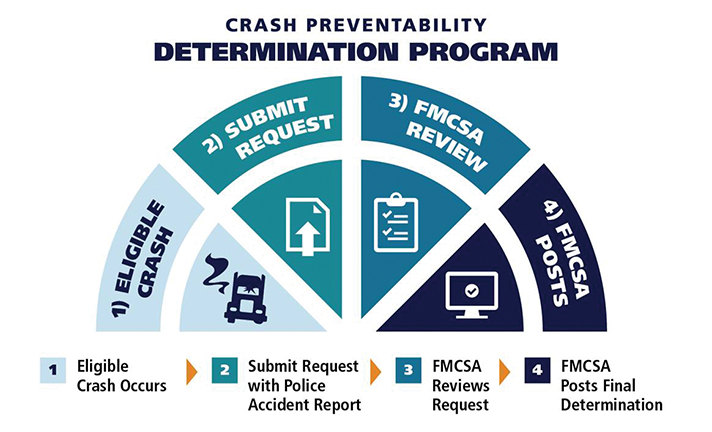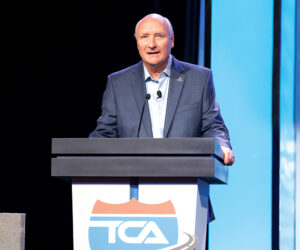Lost amidst the excitement of the release of the new, more flexible hours of service rule, and the attention appropriately being given to the pandemic gripping the nation is this: 2020 is the 10th anniversary of the introduction of the Federal Motor Carrier Safety Administration’s Compliance, Safety, and Accountability (CSA) initiative and its Safety Measurement System (SMS).
Since that time, the FMCSA has used safety performance information in the Behavior Analysis and Safety Improvement Categories (BASICs) to prioritize carriers for safety interventions.
One of the BASICs is the Crash Indicator category which uses a motor carrier’s crashes from the previous 24 months to calculate percentiles for motor carriers.
Although the Crash Indicator BASIC percentiles have never been publicly available, trucking industry stakeholders have long expressed concern that the use of all crashes in SMS, without an indication of preventability, may give an inaccurate impression about the risk posed by the company, thus increasing the number of targeted compliance interventions and giving insurance companies more reasons to impose higher premiums.
In response to this concern, on July 27, 2017, the FMCSA announced a demonstration program to evaluate the preventability of certain categories of crashes.
Based on the results of the demonstration program, FMCSA in May announced it was initiating the Crash Preventability Determination Program (CPDP).
Through this program, motor carriers and drivers may submit eligible crashes for preventability determinations through FMCSA’s DataQs system.
FMCSA will remove crashes that were not preventable by the motor carrier or driver from the SMS prioritization algorithm, will note the not preventable determinations in the driver’s Pre-Employment Screening Program (PSP) record, and will also note not preventable, preventable, and undecided determinations in the motor carrier’s list of crashes on the public SMS website.
“FMCSA’s Crash Preventability Determination Program is a prime example of the Agency listening to the concerns of the industry,” said Truckload Carriers Association Vice President of Government Affairs David Heller. “For years, we have communicated that accidents over which we have no control, or which have been determined to be non-preventable, should not be attributed to a carrier’s safety record.” Heller added that it has even been noted that approximately 75% of the accidents involving a truck and passenger vehicle had been determined to be the fault of the passenger vehicle, yet the accident had a negative impact on the motor carrier’s CSA score.
“The CPDP is an opportunity for carriers to dispute the preventability of a questionable accident in order to more accurately depict their safety performance,” he said. “As an industry, we should not shy away from determining our safety fitness. However, we should insist that the determination be as accurate as possible. The CPDP certainly helps in portraying that.”
During the demonstration program, motor carriers submitted more than 14,700 requests for data review (RDRs). Of the 14,710 RDRs, 9,116 were eligible crash types and of these, 8,444 were found to be not preventable. That means almost 93% of eligible crash type RDRs were found not to be preventable.
FMCSA said 1,950 carriers submitted one RDR, 1,912 carriers submitted between two and nine RDRs, 229 carriers submitted 10 or more RDRs.
The highest number of RDRs submitted by one carrier was 287.
The overwhelmingly largest category of RDRs submitted (6,334) was for an accident when the commercial motor
vehicle (CMV) was struck in the rear. Eighty-three such accidents were determined to be preventable and no decision could be reached on 360.
There were 772 RDRs submitted for accidents when the CMV was struck while legally stopped or parked, including when the vehicle was unattended. Of those, 660 were determined not preventable, 21 preventable, and 41 were undecided.
Next came CMVs struck by a motorist driving under the influence (or related offense) with 688 RDRs submitted, and of those, 636 were determined to be not preventable, 16 preventable, and 36 were undecided.
The FMCSA said that on average, carriers with not preventable crashes removed have a percentile drop of nine points in the recalculated Crash Indicator BASIC.
Finally the determination program found that removing not preventable crashes from the Crash Indicator BASIC should not have an impact on the effectiveness of FMCSA’s prioritization programs.
The FMCSA pointed out that a crash preventability determination does not assign fault or legal liability for the crash.
CRASH PREVENTABILITY DETERMINATION PROGRAM
The Federal Motor Carrier Safety Administration has released detailed information about the Crash Preventability Determination Program.
The following crash types are eligible for participation in the program:
Struck in the rear type of crash when the commercial motor vehicle (CMV) was struck:
- In the rear; or
- On the side at the rear.
Wrong direction or illegal turns type of crash when the CMV was struck:
- By a motorist driving in the wrong direction; or
- By another motorist in a crash when a driver was operating in the wrong direction; or
- By a vehicle that was making a U-turn or illegal turn.
Parked or legally stopped type of crash when the CMV was struck:
- While legally stopped at a traffic-control device (e.g., stop sign, red light or yield); or while parked, including while the vehicle was unattended.
Failure of the other vehicle to stop type of crash when the CMV was struck:
- By a vehicle that did not stop or slow in traffic; or
- By a vehicle that failed to stop at a traffic control device.
Under the influence type of crash when the CMV was struck:
- By an individual under the influence (or related violation, such as operating while intoxicated), according to the legal standard of the jurisdiction where the crash occurred; or
- By another motorist in a crash where an individual was under the influence (or related violation such as operating while intoxicated), according to the legal standard of the jurisdiction where the crash occurred.
Medical issues, falling asleep, or distracted driving type of crash when the CMV was struck:
- By a driver who experienced a medical issue which contributed to the crash; or
- By a driver who admitted falling asleep or admitted distracted driving (e.g., cellphone, GPS, passengers, other).
Cargo/equipment/debris or infrastructure failure type of crash when the CMV:
- Was struck by cargo, equipment or debris (e.g., fallen rock, fallen trees, unidentifiable items in the road); or crash was a result of an infrastructure failure.
Animal strike type of crash when the CMV:
- Struck an animal.
Suicide type of crash when the CMV:
- Struck an individual committing or attempting to commit suicide.
Rare or unusual type of crash when the CMV:
- Was involved in a crash type that seldom occurs and does not meet another eligible crash type (e.g., being struck by an airplane or skydiver or being struck by a deceased driver).
Lyndon Finney’s publishing career spans over 55 years beginning with a reporter position with the Southwest Times Record in Fort Smith, Arkansas, in 1965. Since then he’s been a newspaper editor at the Southwest Times Record, served five years as assistant managing editor of the Arkansas Democrat-Gazette in Little Rock and from November 2004 through December 2019 served as editor of The Trucker. Between newspaper jobs he spent 14 years as director of communications at Baptist Health, Arkansas’ largest healthcare system. In addition to his publishing career he served for 46 years as organist at Little Rock’s largest Baptist church.








